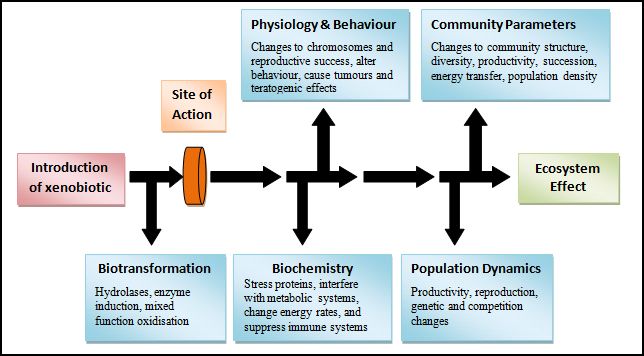When exposure to a toxin that occurs above normal safety levels it will cause adverse effects to biota. The range in impacts depends on the chemical composition and can damage organs, metals will coagulate proteins and organic chemicals combined with naturally occurring reactions can disturb metabolic pathways. The importance of studying environmental toxicology is used to cover the impacts of chemicals on ecological systems and the organisms that are part of them.
Landis and Yu (2004) describe the process following the introduction of xenobiotic matter into the environment. This model is based on the three functions of environmental toxicology and the information is vital in explaining the transfers of toxins and the effects from their interactions with a specific receptor molecule to the effects seen at a physical level. Understanding the functions allows scientists to be able to predict the effects of pollutants in the environment.
The first function, biotransformation describes the distribution of the material after initial release such as hydrolases, enzyme induction and mixed function oxidisation. The second function describes the interaction of the material with the site of action including biochemical parameters and physiological and behavioural parameters. The xenobiotic material in physiological systems may interfere with chromosomes, reproduction success; alter behaviour and cause tumours and teratogenic effects. Biochemically, xenobiotic material may stress proteins, interfere with metabolic systems, change energy rates and increase metallothionen production which suppresses the immune system.
The third function as described by Landis and Yu report that the final stage illustrates the impacts of molecular interaction upon the functions of an ecosystem. This is presented through community and population parameters. The impacts are seen physically through structure, diversity, productivity and population density changes. Alterations in genetic structure, competition, successional state and energy transfer efficiency are also indicators of effects of toxins on an ecosystem.
Ecosystem changes observed through measured variables such as biomass accumulation, landscape alteration, species distribution, net productivity, metabolism (energy capture, flow and loss) and rate of detrital breakdown are indicative of problems. Evaluation of effects must therefore be system specific for environmental regulations that are designed to protect ecosystem structure and function to be most effective.
Reference: Landis, Wayne., Yu, Ming-Ho (2004) ‘Introduction Environmental Toxicology; Impacts of Chemicals Upon Ecological Systems’, 3rd edition, Lewis Publishers, U.S.A.

No comments:
Post a Comment